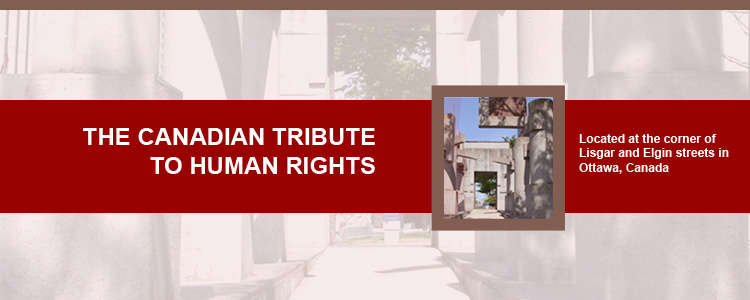
|
|
|
|
|
|
|
|
 |
|||||||||||||
|
|||||||||||||

|
Official UnveilingWilliam Commanda, an Algonquin elder, began the ceremony by burning sweetgrass, symbolizing the coming
together of many hearts and minds. The Canadian Tribute to Human Rights is located on unceded land of
the Algonquin people. The Dalai Lama, assisted by a father with two children randomly chosen from the people in attendance, unveiled the Canadian Tribute to Human Rights. They led the special guests and public in a ceremonial walk through the archway of the monument. In closing, Algonquin drummers invited the public to share traditional bannock and other refreshments. A celebration and fundraising dinner featuring a number of special speakers followed the unveiling. Mr. Edward Broadbent, then president of the International Centre of Human Rights and Democratic Development, gave the keynote address. The day concluded with the world premiere of the orchestral work “Comme des chants d’espoir” composed by Marius Tremblay for the Canadian Tribute to Human Rights and performed by the University of Ottawa Orchestra. “We have this day, September 30, 1990, officially unveiled the Canadian Tribute to Human
Rights. May this place remain as a lasting tribute and inspiration to all who cherish human
rights.” Signed by: Sound collage by Ian Tamblyn: The Declaration of Human Rights (Thoughts by Tamblyn - "A most memorable Gig") Excerpts from the Dalai Lama’s Nobel Peace Prize acceptance address, 1989: “Through persistent non-violent popular efforts dramatic changes, bringing many countries closer to real democracy, have occurred in many places. Sadly, the courageous efforts of the Chinese people to bring similar change to their country was brutally crushed in June, 1989. But their efforts too are a source of hope. The Chinese students have given me great hope for the future of China and Tibet. I feel that their movement follows in the tradition of Mahatma Gandhi’s ahimsa or non-violence which has deeply inspired me ever since I was a small boy. More than a quarter of a million Chinese troops are stationed in Tibet. For 40 years… Tibetans have been deprived of their most basic human rights, including the right to life, movement, speech, worship, only to mention a few. More than one sixth of Tibet’s population of six million died as a direct result of the Chinese invasion and occupation. The suffering of our people is well documented. Because violence can only breed more violence and suffering, our struggle must remain non-violent and free of hatred. We are trying to end the suffering of our people, not to inflict suffering upon others. As part of my Five-Point Peace Plan for the restoration of peace and human rights in Tibet, the entire Tibetan plateau would become a Zone of Ahimsa or peace sanctuary. Any settlement of the Tibetan question will only be meaningful if it is supported by adequate international guarantees.” His Holiness Tenzin Gyatso, the 14th Dalai Lama of Tibet. The following are images from the unveiling event.
|
|
|